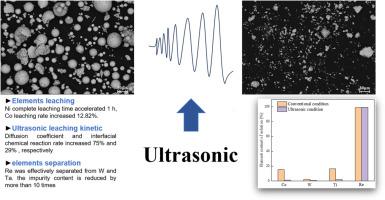Improved elemental recovery from waste superalloy CMSX-4 by ultrasonic strengthening assisted two-step acid leaching
IF 3.9
3区 工程技术
Q3 ENERGY & FUELS
Chemical Engineering and Processing - Process Intensification
Pub Date : 2025-08-05
DOI:10.1016/j.cep.2025.110480
引用次数: 0
Abstract
The low leaching efficiency and incomplete element recovery during the acid leaching process of waste superalloys have been urgent problems in the field of superalloy recycling. In this study, the ultrasonic strengthening assisted two-step acid leaching technology was developed to realize the selective leaching of Re and high recovery efficiency of all elements from CMSX-4. The effects of the ultrasonic strengthening on leaching efficiency and morphological evolution, and the leaching kinetics behind were systematically investigated. The results showed that the applied ultrasonic strengthening not only improved the leaching rate, but also increased the final leaching efficiency. Compared with conventional condition, the leaching rate of Co and Ti were 1.17 times and 1.27 times higher than that without ultrasonic strengthening, respectively. The leaching efficiency of Re after secondary acid leaching under ultrasonic conditions is 99.26 %, and the impurity content in the acid leaching solution is reduced by more than 10 times, which not only simplifies the purification process of the solution, but also achieves efficient recovery of each valuable element. Ultrasonic strengthening destroyed the inner structure of waste superalloy, which improved the specific surface area 0.11 times and reduced the diffusion resistance by 0.75 times, respectively. Applied ultrasonic strengthening assisted acid leaching is expected to enable the recycling of less-soluble secondary resources.

超声强化辅助两步酸浸提高废高温合金CMSX-4的元素回收率
废高温合金酸浸过程中浸出效率低、元素回收不完全是高温合金回收领域亟待解决的问题。本研究开发了超声强化辅助两步酸浸工艺,实现了CMSX-4中Re的选择性浸出和各元素的高回收率。系统研究了超声强化对浸出效率和形态演化的影响及其浸出动力学。结果表明,超声波强化不仅提高了浸出率,而且提高了最终浸出效率。与常规条件相比,Co和Ti的浸出率分别是超声强化条件下的1.17倍和1.27倍。超声波条件下二次酸浸后Re的浸出效率为99.26%,酸浸液中的杂质含量降低了10倍以上,不仅简化了溶液的纯化过程,而且实现了各有价元素的高效回收。超声强化破坏了废高温合金的内部组织,比表面积提高了0.11倍,扩散阻力降低了0.75倍。应用超声强化辅助酸浸有望实现难溶性二次资源的回收利用。
本文章由计算机程序翻译,如有差异,请以英文原文为准。
求助全文
约1分钟内获得全文
求助全文
来源期刊
CiteScore
7.80
自引率
9.30%
发文量
408
审稿时长
49 days
期刊介绍:
Chemical Engineering and Processing: Process Intensification is intended for practicing researchers in industry and academia, working in the field of Process Engineering and related to the subject of Process Intensification.Articles published in the Journal demonstrate how novel discoveries, developments and theories in the field of Process Engineering and in particular Process Intensification may be used for analysis and design of innovative equipment and processing methods with substantially improved sustainability, efficiency and environmental performance.

 求助内容:
求助内容: 应助结果提醒方式:
应助结果提醒方式:


